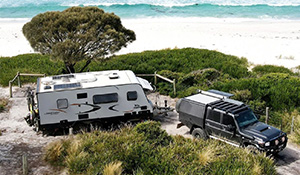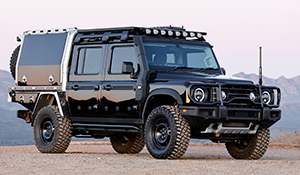Review: 2016 Volvo XC90 T6 R-Design
WHEN THE HISTORY OF THE SUV is written, the XC90 will have a special place in the chronology as one of the game changers, along with the likes of Range Rover, Mitsubishi Pajero and Land Rover Discovery 3.
It was back in 2002 that the first-generation Volvo XC90 was released becoming an instant hit because of its intelligent, spacious seven-seat design, it looked modern, drove nicely, offered lots of safety gear and deservedly became the benchmark seven-seat soft-duty SUV. So successful was the car that it survived another 12 years without a significant change. The second-generation was revealed in 2014 and launched here last year.
Our test car is the range topping XC90 T6 R-Design which lists from $101,670+ORC.

What’s the interior like and how practical is it?
The original Volvo XC90 managed to set the benchmark for what was expected from a seven-seat SUV. This new one continues the big Volvo’s dominance in this space, and this is why…The third row is a 50:50 split and level with the boot lip. The seats fold completely flat and latch in place. And even with them in use there’s a good amount of room behind the seats.

The cargo area has a roof light, two side lights and a light in the top of the boot, so it’s a very well-lit space compared to others. There are four strong tie-down points in the boot, and Volvo includes a cargo net which can be stored in a neat little compartment accessible when the third row is up. There’s room for a few more odds and ends where you store the cargo net, too. Each of the third-row occupants gets a drinks holder and a small storage compartment. Anyone around six-feet tall will find the third-row a little snug, but there’s decent legroom, making this a genuine seven seat vehicle. At the rear of the car we found our tester had a foot-operated power tailgate, but nobody could get it to work consistently, and we had several people try. This new model has a one-piece tailgate, in contrast to the previous model which had a horizontally split tailgate. The difference is personal opinion, but a one-piece is cheaper and lighter and doesn’t restrict access to the back. The two-piece means you have a built-in mini table, and the back of the car becomes a handy box to throw things into without fear of them falling out over the boot lip. Moving forwards through the XC90 and there are three child restraint points, all high up on the back of the second-row seat where they are easy to access. The middle second row seatbelt is built into the seat, not hanging from the roof, and the outer second-row seatbelts are height adjustable, ideal for kids and something very rarely seen in cars.

The second row is a triple split and folds completely flat to offer more than two-metres of load space. Each of the three seats can be moved forwards and backwards, and the middle seat can accommodate an adult in reasonable comfort, albeit with a firm seat base. The XC90 will also seat three abreast, not something every SUV can do comfortably.
The middle second row can be reconfigured as a booster seat, a feature that will be most welcome for kids of that size between car seat and full seat. There’s no way to operate the third row up or down from the back of the car – one might reasonably expect a release, if not electric seats like some Ford Everest and Haval H9 variants, but no… The third row has no child restraints, either and while there is a cargo blind it is a bit fiddly to use.

Up front the XC90 could do a bit better. In my opinion there are insufficient storage compartments for driver and passenger, and the centre console is a little small. There’s no USB outlet for the second or third row. You do, however, get one 12V socket up front, one in the middle and one in the boot, and just one USB port in the centre console. That said, it’s good to see the glovebox is split-level and cooled. Overall, the XC90 retains its position as one of the very best family-friendly, practical and stylish seven seaters. There is enough there to warrant extra money over cheaper alternatives which do not offer the seating flexibility, sense of design or refinement. However, it is a little surprising that Volvo has not moved the market forwards as it did with the original XC90 – there’s no wow factor, nothing special about the interior that makes the car stand out, just all the basics done well and all the usual mistakes avoided.

What’s the communications and infotainment system like?
The XC90 has a touchscreen and, Volvo boasts that it has reduced the number of physical buttons. Mixed feelings here – firstly, in my view no touchscreen is ever as a good as a set of buttons and switches which can be operated without looking and quickly flicked to the appropriate setting. However, the Volvo touchscreen is about the best I’ve used: simple, intuitive, large, clear and responsive, such a refreshing change from the smaller ones with randomly organized interfaces which send you into a stabby-fingered rage. It is modelled on a smartphone with swipe left/right, a home button and taps. There’s so much to like about it; it’s easy to enter and cancel navigation, Bluetooth audio shows an image of the artist, all the settings are in one place and the map can be set to take up different screen spaces. Volvo includes some apps that require an Internet connection, so connect we did and they all started demanding updates before hanging and refusing any further coaxing. Test over. Well, nearly – the final word is that the screen is prone to smudging (the photos are always real-world so you can see for yourself), but Volvo is a step ahead and has provided a special little wiping cloth with instructions.

The owner’s manual is mostly electronic, which means the car needs to be on and functional for it for work. However, it is easy enough to use, although being a bit quicker to respond wouldn’t hurt. In contrast to the main screen the driver’s dash is a bit of a disappointment. It can show navigation information and music details, but otherwise doesn’t really complement the main display in the same way as, say, a Prius. And that’s surprising, given the display is a pure TFT screen. Volvo could have, and should have done a lot more with it. The sound system in our tester was the premium $4500 option from Bowers and Wilkins, which unusually for premium audio manufacturers use capital letters in their name. Despite that, there were no complaints about the sound and while I am no audiophile I did note the rich quality of the music. Still, as ever with such systems, I’m not entirely convinced the extra is worth it. You can option a CD player for $160 if you like yesteryear’s technology. There’s a good array of speakers, including a set in the third row.

What’s the performance like?
All XC90s are on-demand all-wheel drive, which means they mostly drive the front wheels with the rears coming in as needed. This second-generation car is also fitted with an eight-speed automatic as standard. Our test car had the “Polestar Performance Optimisation” modification which, Volvo says, “improves the performance of your Volvo. It makes the car more active to drive and it increases safety in situations where you need extra performance, for example when overtaking or entering a busy highway. All this without affecting the Original Warranty of your Volvo.” The cost for the modification is $1858.05 plus half an hour’s labour, and it’s just a software change. The result is an increase in peak power from 235 to 246kW and more torque, up from 400 to 440Nm. Acceleration from 0-100 is down to 6.4 seconds from 6.5. Fuel consumption and emissions are unchanged, and the change can be rolled back although there’s no refund...
There are four driving modes; Eco, Comfort, Dynamic and Off-road which can be selected only at low speeds. These change the throttle response, gearshift points and electronic systems calibration. The XC90 offers plenty of power, but it’s how that power is handled by the transmission that becomes the main issue. I suspect it’s the fault of the Polestar “optimisation” but there’s little about the XC90 R-Design that’s relaxing. For example, the transmission is too eager to slam down a hasty gear when it doesn’t need to, such as unhurried but not dawdling acceleration on exit from a roundabout. I think Volvo confused ‘sporty’ with ‘dramatic’. Driving the car in Eco mode calmed it a bit, but not enough.
Another niggle is the stop/start system which kills the engine just before you’re stopped under light braking, and restart it again once you actually are stopped and that can lead to a jerk. So overall, the engine/transmission combination is a disappointment and I’d like to drive one without the Polestar pack to see if it’s any better.

What’s the ride and handling like?
The XC90 is an accomplished cruiser. The adaptive cruise control is very good indeed, easy to adjust in either 1 or 5km/h increments, and easy to see what it’s set to. The lane keep assist and other driver aids are beautifully calibrated and really do help the driver. The LED headlights are, as they generally tend to be, highly effective. They are also “Active Bending Headlights” which means they illuminate the direction of travel as you take a corner. You don’t notice it around well-lit suburbs, but it is helpful on dark country roads.
The XC90 really is a car you’d want to take interstate, able to cover long distances in relaxed and safe comfort. That said, the cruise control doesn’t hold speed downhill which for this sort of car is a little bit frustrating. And the same goes for when you start to push the XC90… the R-Design is meant to be the sporty variant in the pack but it comes off feeling adequate rather than exciting. Sure, there’s a Dynamic drive mode but it makes next to no difference to the overall experience. Our test car had the extra-cost 22-inch wheel option ($3850) which not only ruined the ride on dirt roads but also made me paranoid about wheel damage and punctures, so I can’t deliver a full opinion on the car’s rough-road performance. However, with the reduction in road grip the front-drive bias became more apparent – accelerating out of a corrugated corner for example – and that’s too much to be an ideal dirt-road cruiser. The Volvo is definitely no sharp rally car. We were never going to do a full off-road test, but I did enough playing around in a wet, dirt-road motorbike park to learn a few things.

First, the Haldex all-wheel drive system which Volvo has used in the XC90 has been replaced by a GKN system. This is excellent news as Haldex have never made very good all-wheel drive systems, being far too slow to bring the rear wheels into play. There’s also an Off-road driving mode which, I’m happy to report, disables (or at least reduces) the stability control while leaving the brake traction control alone. Pay attention, all you other SUV makers, that’s the way these things should be done. This good bit of design means that once the Off-road mode is engaged the XC90 can make surprisingly good progress across slippery and uneven terrain, better than, say, either a Toyota Kluger or Lexus SUV but nowhere near that of a 4x4 like the Land Rover Discovery. If you come to a halt with diagonal wheels in the air and then attempt to move off, the traction control will chatter away until you feed in a little more power – then it will settle and help you to keep moving forwards. Ground clearance isn’t stated in the specifications, but I measured it at about 210mm, which is pretty decent for a vehicle of this nature. The off-road work XC90s are going to do is likely to be snow and sand, maybe even some shallow slippery mud. I didn’t get a chance to properly evaluate the car across those terrains, but based on what I was able to test I’d say it’d be reasonably effective once in its off-road mode – much better than its predecessor.

How safe is it?
Safe, and even safer if you cost-option what should be standard. The options are fully discussed below, but I’d be ticking the safety boxes as Volvo’s tech is decent value, and actually works very well. The lane keep assist is effective and while you can feel it, it never becomes annoying. The automatic emergency braking (City Safety) can be fooled when passing a single parked car, but otherwise you’re not really aware of the tech. Hard braking is stable and predictable, with ABS, EBD and EBA all helping figure out how to stop quickly. And visibiity is great all round. There are other little touches such as the car not letting you disengage the park brake to pull away without putting a seatbelt something all other cars should do too. The vehicle has Run Off Road protection which is where it realises it has left the road and doom is impending so it tightens the seatbelt and prepares for a crash. Obviously we didn’t test out this feature, and nor did we get the Drive Alert fatigue detection to trigger. The ANCAP rating is 5-star, and that is with the most stringent 2016 criteria. Specifically, the car rated 37.02 out of 38 for adult protection, 40 out of 43 for child protection, and 9.55 out of 13 for safety assist technology. The reversing camera is excellent, very high quality and has a zoom function plus moving guidelines. Not all reversing cameras are equal. The front/rear sensors work well, and the infotainment unit shows what bit of the car you’re about to hit, and there’s an audio warning too. The spare wheel is a space saver and there is no way you’re fitting anything else in its bay, so if you need to use the spare you will welcome a punctured full-sized wheel into the boot. Still, that’s better than a run-flat tyre.

The verdict?
The case for the XC90 is very clear. It’s just about the best seven-seat SUV on the market because it has an intelligent, practical interior and a collection of genuinely useful safety aids. It’s what you buy if you want a quality seven-seater and can afford to go beyond Japanese or Korean equivalents. That said, there are three areas in which the XC90 wouldn’t be your first choice. The first is towing, as with a 2250 or 2400kg rating it’s well below par compared to, say, the Land Rover Discovery which can manage 3500kg. The second is handling. Despite Volvo’s marketing, the XC90 is adequate but it is no BMW X car. And the third is off-road. While it is hugely improved over its predecessor (from which the only possible direction was up) the XC90 is not and never will be an off-roader. Again, potential buyers are directed to the Discovery, the LandCruiser 200 Series or the Nissan Y62 Patrol. But, if all you want to do is mostly road work in practical seven-seat style, then the XC90 should be near the top of your list.
By Robert Pepper











Specification: 2016 Volvo XC90 T6 R-Design
PRICING $101,670 +ORC
PRICE AS TESTED $121,225+ORC
WARRANTY 3 YEARS UNLIMITED KILOMETRES
ENGINE 2.0-LITRE FOUR-CYLINDER SUPERCHARGED AND TURBOCHARGED PETROL
POWER 235KW AT 5700RPM
TORQUE 400NM AT 2500-5400RPM
TRANSMISSION 8 SPEED AUTOMATIC
DRIVE ON-DEMAND AWD
DIMENSIONS 4950MM (L); 2008MM(W); 1776MM(H)
TURNING CIRCLE 11.8M
SEATS 7
TARE WEIGHT 1965KG
FUEL TANK 71L
FUEL CONSUMPTION 8.5L/100KM COMBINED CYCLE FUEL PETROL 95 RON
SPARE SPACE SAVER
TOWING 750KG UNBRAKED, 2250KG BRAKED, MAX TBM 140KG









